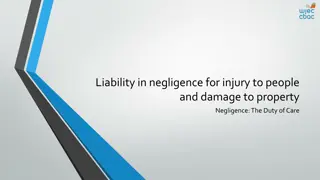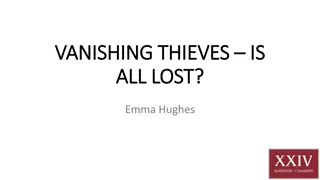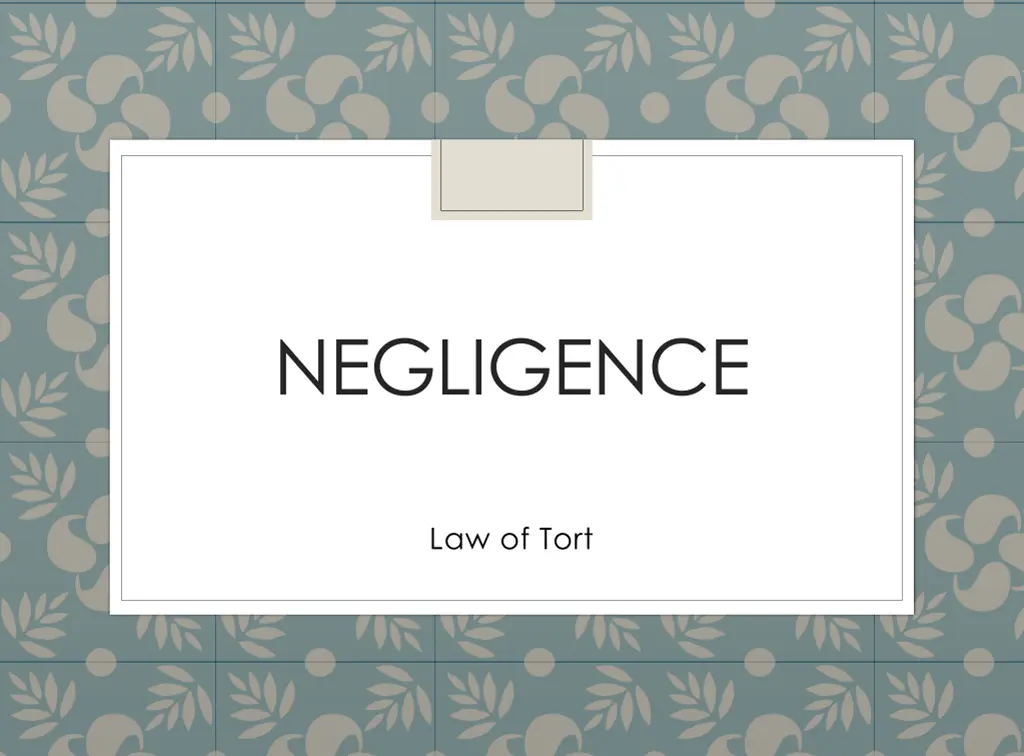
Understanding Negligence in Tort Law
Learn about negligence in tort law, its definition, and the elements required to establish legal accountability for negligence, such as duty of care, breach of duty, and causation. Explore key risk factors affecting breach of duty and significant cases highlighting special characteristics of claimants in negligence claims.
Download Presentation

Please find below an Image/Link to download the presentation.
The content on the website is provided AS IS for your information and personal use only. It may not be sold, licensed, or shared on other websites without obtaining consent from the author. If you encounter any issues during the download, it is possible that the publisher has removed the file from their server.
You are allowed to download the files provided on this website for personal or commercial use, subject to the condition that they are used lawfully. All files are the property of their respective owners.
The content on the website is provided AS IS for your information and personal use only. It may not be sold, licensed, or shared on other websites without obtaining consent from the author.
E N D
Presentation Transcript
NEGLIGENCE Law of Tort
Negligence The omission to do something which a reasonable man, guided upon those considerations which ordinarily regulate the conduct of human affairs, would do, or something that a prudent and reasonable man would not do Baron Anderson (Blyth v Birmingham Waterworks) There are three main components that need to be established in order to find someone legally accountable for negligence 1. Duty of Care 2. Breach of Duty 3. Damage/s as a result of the Breach (causation + remoteness)
2: Breach of Duty - Risk Factors A number of factors can be said to raise or lower the standards expected; i.e would a reasonable man take more or less care in certain situations? Four key risk factors 1.Are there any special characteristics of the claimant? 2.What is the size of the risk? 3.Have all practical precautions been taken? 4.What are the benefits of taking the risk?
Are there any special characteristics of the claimant? Paris v Stepney Borough Council (1951) The claimant only had sight in one eye due to in injury sustained in the war. During the course of his employment as a garage hand, a splinter of metal went into his sighted eye causing him to become completely blind. The employer did not provide safety goggles to workers engaged in the type of work the claimant was undertaking. The defendant argued there was no breach of duty as they did not provide goggles to workers with vision in both eyes and it was not standard practice to do so. There was therefore no obligation to provide the claimant with goggles. Held: There was a breach of duty. The employer should have provided goggles to the claimant because the seriousness of harm to him would have been greater than that experienced by workers with sight in both eyes. The duty is owed to the particular claimant not to a class of persons of reasonable workers.
Are there any special characteristics of the claimant? Walker v Northumberland County Council (1995) A social worker in charge of a team of field workers had reported his stress, arising out of a greatly increased workload. On his return to work he was given to understand that he would have an assistant to ease his workload, but it turned out that this assistant was only intermittently available. He suffered a second breakdown and had to retire. This case established the precedent that an employer can be held liable for mental injury to an employee caused by work-related stress. This judgement underlined the employer s duty of care to provide safe systems of work in respect of occupational stress as well as other hazards, and to take steps to protect employees from foreseeable risks to mental health.
Are there any special characteristics of the claimant? Morrell v Owen (1993) At a sports event specifically devised for disabled athletes there were two activities; discus and archery, taking place in the same hall. These activities were only separated by a curtain. The curtain billowed out from time to time over the course of the day as the discus struck it. The clamant was an archer who was close to the curtain when a discus struck her head (through the curtain) and caused brain damage. A higher standard of care is expected of organisers and sports coaches to disabled athletes because of their special needs.
What is the size of the risk? Risk = Care needed Bolton v Stone (1951) What happened in this case? What was the POL?
What is the size of the risk? Haley v London Electricity Board (1964) Some workmen were digging a trench in a pavement. They went off to lunch. They had nothing to fence of the trench so they left a shovel and pick at one end and a punner (tool) at the other end to warn pedestrians. The claimant, a blind man, tripped on the punner and fell hitting his head. As a result of the fall he became deaf. The defendant argued they had done all that was necessary to warn an ordinary person of the danger and there was no need to take extra precautions for blind persons as it was not foreseeable that a blind person would be walking unaided down that street. Held: The defendant was in breach of duty. It was foreseeable that a blind person might walk down the street and they should be given appropriate protection.
Have all practical precautions been taken? This is a common sense interpretation e.g the fence in Bolton v Stone was a practical precaution but the tool in Haley v London Electricity Board was not. Latimer v AEC The claimant worked in the defendant's factory and slipped up on the factory floor. The factory had become flooded due to adverse weather conditions. The defendant's had put up warning signs mopped up and used all of its supply of sand and sawdust to try to dry the most used places to make it as safe as possible. Held: There was no breach of duty. There was no duty to close the factory. The defendant only had to take reasonable precautions to minimise the risk which they had done. There was no need to go to great expense to eliminate any possible risk and thus no obligation to close the factory.
What are the benefits of taking the risk? This factor is sometimes called public utility . This means that the standard of care required in an emergency is likely to be lower Watt v Hertfordshire County Council (1954) The claimant was a fireman. A woman had been involved in a traffic accident and was trapped underneath a lorry. This was 200-300 yards away from the fire station. The fire services were called to release the woman. They needed to transport a heavy lorry jack to the scene of the accident. The jack could not go on the fire engine and the normal vehicle for carrying the jack was not available. The fire chief ordered the claimant and other firemen to lift the jack on to the back of a truck. There was no means for securing the jack on the truck and the firemen were instructed to hold it on the short journey. In the event the truck braked and the jack fell onto a fireman s leg causing severe injuries. Held: There was no breach of duty. The emergency of the situation and utility of the defendant's conduct in saving a life outweighed the need to take precautions.
What are the benefits of taking the risk? Day v High Performance Sports (2003) The Claimant fell whilst climbing on an indoor climbing wall. She had failed to tie onto her top rope and then to her belayer on the ground below. The Duty Manager tried to rescue her. The way he tried was inappropriate and caused her to fall. The Claimant was a reasonably experienced climber and she had confirmed acceptance when she joined of the conditions of use and the rules of the Centre, which clearly put the burden on her to ensure that she was tied on when she climbed. Held: The centre had not broken its duty.
Homework tasks - In the news Firefighters leave man to drown Read the article and decide whether; 1.There was and duty of care 2.There was a breach of duty (reasonable man + risk factors) Use cases and POL to prove your conclusion
Homework scenario Yannick and Zoe, university students, were at a music festival organised by XS Ltd. They were sitting on the ground in the main tent, listening to a band, when one of the tent support became detached and the tent collapsed. Yannick suffered severe head and neck injuries.









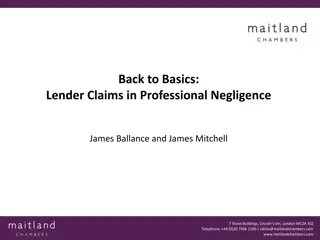
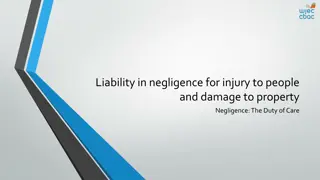





![Negligence Liability in Donoghue v. Stevenson [1932]](/thumb/198881/negligence-liability-in-donoghue-v-stevenson-1932.jpg)
